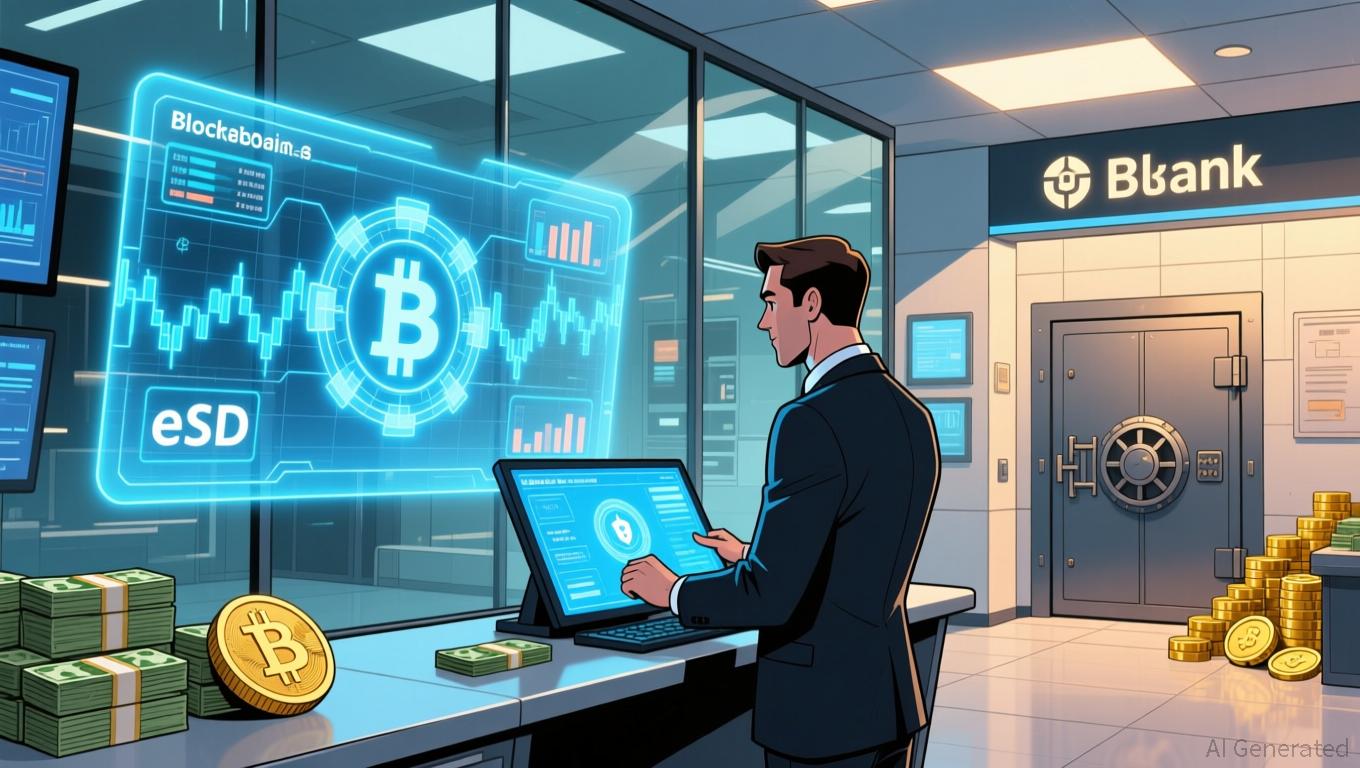JPMorgan and DBS Introduce Blockchain Network to Integrate Tokenized Currencies
- JPMorgan and DBS Bank launch blockchain framework for tokenized deposit interoperability, enabling real-time cross-border payments between institutional clients. - The system allows 24/7 instant exchange of tokens across public/permissioned blockchains while preserving fungibility and "singleness of money" value equivalence. - DBS' Rachel Chew highlights interoperability's role in reducing fragmentation, as 30% of global banks now explore tokenized deposits per BIS data. - The initiative aligns with broa
JPMorgan Chase and Singapore’s DBS Bank have unveiled a pioneering partnership to create a blockchain-powered interoperability framework for tokenized deposits, aiming to facilitate instant, cross-border payments for institutional clients. This collaboration, which connects JPMorgan’s Kinexys Digital Payments with DBS Token Services, seeks to set a new benchmark for digital asset movement across both public and private blockchains. The alliance highlights the increasing momentum among international banks to harness blockchain technology for swifter and more streamlined financial systems.
This framework enables clients to instantly swap or redeem tokenized deposits at any time, regardless of which blockchain is used. For instance, a
Rachel Chew, Group Chief Operating Officer and Head of Digital Currencies at DBS, highlighted the importance of interoperability: “Around-the-clock instant payments give businesses flexibility, speed, and the ability to respond to global changes and seize new opportunities. Ensuring interoperability is essential to minimize fragmentation and guarantee that the full value of tokenized money can move securely across borders.” Naveen Mallela, Global Co-Head of Kinexys by JPMorgan, remarked that this partnership demonstrates how financial institutions can “expand the advantages of tokenized deposits while safeguarding the integrity of money and supporting market interoperability,” as reported by
This initiative is part of a larger industry movement toward tokenized financial services. According to a 2024 survey by the Bank for International Settlements (BIS), nearly one in three commercial banks worldwide have launched, tested, or investigated tokenized deposit offerings. Other leading banks, such as BNY Mellon, Barclays, and HSBC, are also progressing with blockchain-based payment pilots. JPMorgan’s recent deployment of JPMD tokens on BaseScan—a
The DBS-Kinexys framework tackles a central obstacle in digital asset adoption: enabling interoperability between different blockchain networks. By establishing a “highway” for cross-chain transactions, this partnership reduces dependence on conventional banking systems and mitigates settlement risks. The project builds on JPMorgan’s earlier collaboration with the MIT Digital Currency Initiative, which set standards for interoperability of bank tokens on open blockchains, as reported by
Experts believe this initiative could pave the way for future international partnerships. “When two major banks from different parts of the world join forces to address real-world challenges like fragmented payment networks, it’s more than just discussion. It signals that tokenized finance is reaching a new level of maturity,” a commentator told SQ Magazine. The framework’s progress could drive broader adoption, especially as regulatory frameworks become clearer and interest in programmable money increases.
JPMorgan and DBS Build Blockchain Bridge for ...
JPMorgan, DBS eye deposit tokens as cross-bank alternative to stablecoins
DBS and J.P. Morgan Team Up to Transform Tokenized Deposits
JPMorgan and DBS to Launch Blockchain System for ...
JPMorgan and DBS Bank Team Up on Cross-Border Tokenised Deposit Framework
Disclaimer: The content of this article solely reflects the author's opinion and does not represent the platform in any capacity. This article is not intended to serve as a reference for making investment decisions.
You may also like
Supervised Blockchain Banking Connects Traditional Finance and Digital Assets
- Telcoin becomes first U.S. digital asset bank with Nebraska regulatory approval, launching eUSD - the first bank-issued stablecoin backed by U.S. deposits and treasuries. - JPMorgan's JPMD deposit tokens enable instant 24/7 transactions on Base blockchain, offering yield-generating digital claims on actual bank deposits unlike traditional stablecoins. - Thunes' blockchain infrastructure solutions bridge digital-physical finance gaps, supporting $10B market growth by enabling seamless fiat-digital asset c

Bitcoin News Update: Bipartisan Deal Faces Delays Due to Healthcare Disagreements and Trump Tariff Challenges
- U.S. lawmakers near bipartisan deal to end 40-day government shutdown, funding federal operations through January 30 with ACA tax credit votes and Trump's reversed firings. - House Democrats split over healthcare provisions, while Senate faces hurdles in passing funding package due to healthcare disputes and procedural challenges. - Markets react mixed: crypto surges on shutdown resolution optimism but ETFs see outflows, while semiconductors face volatility amid analyst price target adjustments. - Prolon

MMT Token Experiences Rapid Price Increase: Analyzing Blockchain Governance and Factors Driving Market Sentiment
- MMT Token surged 4,000% during its 2025 TGE before a 70% correction, driven by governance innovation and market sentiment shifts. - Momentum Finance's veMMT model locks tokens for governance rights, while buybacks using protocol fees create deflationary pressure. - Institutional backing ($14.5M IDO) and cross-chain partnerships with Wormhole/LiFi boosted MMT's appeal as a liquidity engine for Sui's ecosystem. - Volatility risks persist due to macroeconomic factors, security concerns, and unproven scalabi

Modern Monetary Theory and the Transformation of Cryptocurrency Valuations: Fresh Momentum or a Risky Gamble?
- MMT-driven fiscal expansion by central banks reshapes crypto valuations, with 55% of hedge funds holding digital assets by 2025. - Algorithmic stablecoins like USDsd expose governance flaws during monetary expansion, while Bitcoin faces inflation-paradox challenges. - CBDCs emerge as government-backed alternatives, prioritizing stability over innovation amid regulatory scrutiny of decentralized models. - MMT's dual impact creates opportunities for institutional adoption but risks centralizing crypto thro
